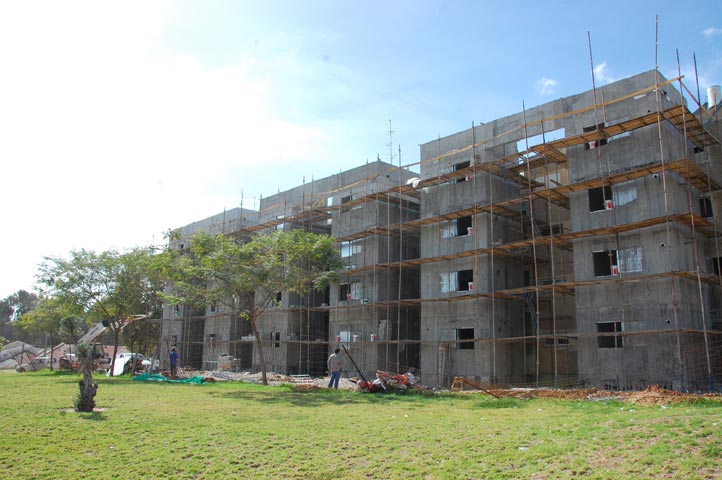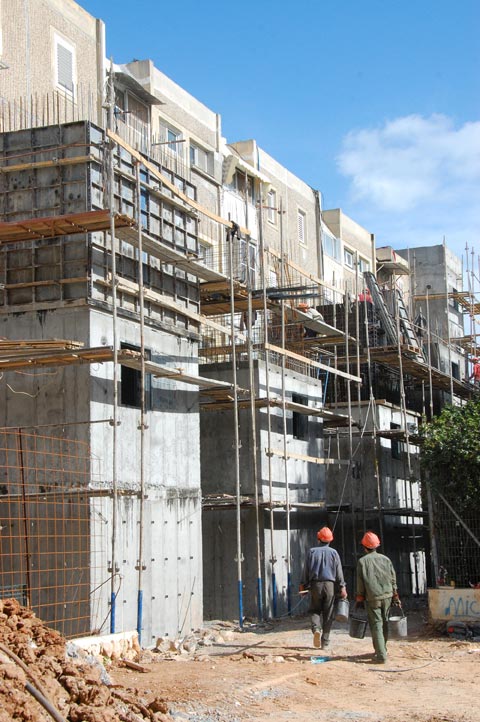Recent protests by Ashkelon residents and the local PTA in demanding full rocket protection for school buildings across the city put us at the Sderot Media Center, in a moral dilemma. Should we join in their struggle?
On one hand, we fully understand and identify with Ashkelon’s population of 120,000 residents who battle for school protection which could save lives from expected Gaza missile attacks. On the other hand, we cannot help but ask, should this struggle be for protection of the city or for the cessation of the threat of aerial attacks from Gaza? Only last week, a rocket exploded in south Ashkelon, bringing to 349 the number of rockets and missiles fired into Israel since the cease fire stopped Israel’s three week incursion into Gaza in January 2009. Will protecting the city stop the rockets? It is clear to everyone that it will not.
Building shelters in Sderot
At the Sderot Media Center, our agency has consistently reported on the struggle to get to the Israeli government to provide appropriate shelter for Israeli communities along the Gaza border. Back in April 2007, the SMC staff, in collaboration with researchers at Sapir College, conducted an investigation into the shelter protection in Sderot and the western Negev. The investigation was accompanied by the local PTA of Sderot, who demanded that decision makers and the Israel High Court fortify the 24 schools in Sderot and the surrounding area.
Massive bomb shelter building project in Sderot. (Photo: Noam Bedein/Sderot Media Center)
he findings of our research, published on the Israeli news website NEWS1.co.il, headed by investigative journalist Yoav Yitzchak, highlighted significant failures pertaining to shelter policies in Sderot. The report showed that out of the 57 shelters in Sderot, 25 did not have running water or electricity. Sufficient protection for schools was also lacking, with protection provided only for school children under the age of nine. Schoolchildren in Sderot and the Gaza-border communities were expected to race from unprotected classrooms in which they were learning, to a shelter within 15 seconds of the siren sounding. To us, this was inconceivable at the time. Indeed, until two years ago, a nine-year-old boy was expected to study in an unprotected classroom even during the worst of rocket escalations, when 10-12 rockets would strike Sderot throughout the day. When the ‘Color Red’ siren sounded, this nine-year old student and 80 other schoolchildren would run through the school hallways, hoping to reach a protected space within 15 seconds or less. Like the shelters in Sderot, the Color Red warning system is not foolproof.
There were situations when both shelters and the siren system did not suffice– the last person killed by a Qassam in Sderot, was killed in a direct hit, when no Color Red siren activated. Dependence on an electronic system to sound off warnings and bomb shelter protection to keep out rocket shrapnel is not a long term solution to the problem, even if these devices do save lives. Even the reliability of the shelters is now questionable. The shelters built for schools in Sderot can withstand up to three kilograms of explosives.
Today the Qassam and grad missiles produced in Gaza carry anywhere from 12-20 kilograms of explosives, sometimes even more, which no school shelter in Sderot can withstand. At the end of the day, these shelters can do nothing to prevent the heavy psychological trauma and PTSD symptoms among Sderot’s younger generations as children and adults, which are a direct result of rocket fire.
Results from the Sderot bombshelter investigation
Thanks to the bombshelter investigation initiated by The Sderot Media Center, pressure was applied on Knesset decision makers to introduce some changes. These investigative reports were translated into English and disseminated internationally as well. What resulted was that several overseas Jewish organizations in England turned to the Israeli embassy in London and demanded accountability. The Knesset took notice and a dialogue ensued with the spokesman for the- Prime Minister, Ehud Olmert, who invited our staff to a meeting at the Knesset, where we discussed the budget for school protection in Sderot and the western Negev.
Eighteen months ago, the government approved a law determining that every community, kibbutz or city that is located 4.7 km away from Gaza, will receive government funding for shelters including educational institutes within that range This happened following the recommendation of the defense establishment and after a direct query from the PM office.
Today it’s Ashkelon, tommorow it will be…? / So what range from Gaza is fighting for shelter fortification?
The city of Ashkelon is located 15-20 kilometers from Gaza. Massive missile attacks on the city began in March 2008. Countless Iranian Grad missiles which can damage a radius of up to 300 meters, repeatedly struck strategic areas across the city including Ashkelon’s industrial zone, which provides more than 70% of Gaza’s electricity. One of the worst rocket attacks took place on an outdoor shopping mall, where Dr. Mirela Siderer, a gynecologist who was invited to testify along with me, before the UN’s Goldstone Commission, was severely injured, as well as a baby and young mother and 90 other people.
During Operation Cast Lead, an Ashkelon school was also directly hit in a rocket strike.
So what do we do now?
If Ashkelon is fortified, then every city, kibbutz and community located within the 20 km radius of Gaza will have to be protected as well. And if Ashdod and Be’er Sheva will be in range in the next missile escalation, then these major cities will need fortification?
The total cost for government fortification of only Sderot and Gaza, is about half a billion dollars. Ashkelon is both a strategic and goal of Hamas. Ashkelon is far larger and more populated than any other area Hamas has struck before so frequently. Hitting Ashkelon is also popular in Gaza since Ashkelon is built on the ruins of the Arab village of Majdal, whose descendants now live in UNRWA camps.70% of the Gaza population live in UNRWA refugee camps, who are kept there under the premise and promise of the right of return to the places like Majdal. Today, security officials estimate that rockets fired from Gaza can reach as far as Tel Aviv. As the rocket threat spreads across Israel, including the southern, northern and western parts of the country, a solution must be sought that puts an end to the rocket and missile threat that plagues Israel. The solution does not lie in “fortifying Israel”. The challenge for Israel is to solve the problem in Gaza–not in Ashkelon.
Translated by Anav Silverman.
Noam Bedein is a photojournalist, lecturer and founder/director of Sderot Media Center . He has conducted briefings and tours for government officials, diplomats, foreign press, and students from around the world











